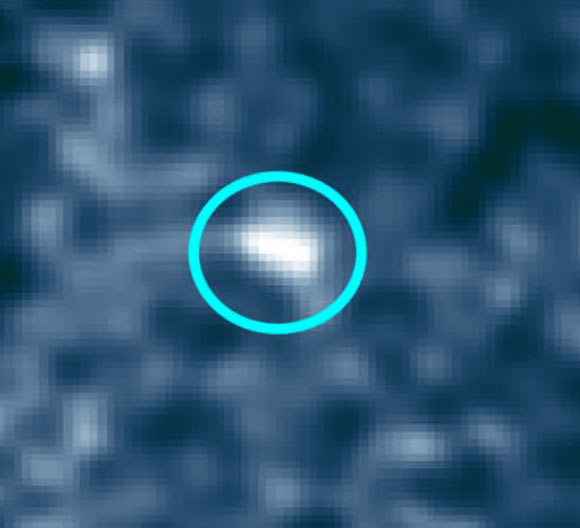Astronomers using the Multi Unit Spectroscopic Explorer (MUSE) instrument on ESO’s Very Large Telescope (VLT) in Chile have detected six dark galaxies, gas-rich galaxies without stars, located 12 billion light-years away.

One of the six dark galaxy candidates detected by the team. Image credit: Marino et al, doi: 10.3847/1538-4357/aab6aa.
Dark galaxies are small, gas-rich galaxies in the early Universe that are very inefficient at forming stars. They are predicted by theories of galaxy formation and are thought to be the building blocks of today’s bright, star-filled galaxies.
Astronomers think that they may have fed large galaxies with much of the gas that later formed into the stars that exist today.
Because they are essentially devoid of stars, these dark galaxies don’t emit much light, making them very hard to detect.
“Despite substantial progress over the past half a century in understanding of how galaxies form, important open questions remain regarding how precisely the diffuse gas known as the intergalactic medium is converted into stars,” said ETH Zürich astronomers Raffaella Anna Marino and Sebastiano Cantalupo and their colleagues.
“One possibility, suggested in recent theoretical models, is that the early phase of galaxy formation involves an epoch when galaxies contain a great amount of gas but are still inefficient at forming stars.”
“Direct proof of such a ‘dark phase’ has been so far elusive, however — after all, dark galaxies do not emit much visible light. The observational discovery of such galaxies would therefore fill an important gap in our understanding of galaxy evolution.”
To overcome the obstacle that their target objects are so dim, the astronomers used a ‘flashlight of sorts, which came in the form of quasars.’
“Quasars are very bright, distant galaxies that are believed to be powered by supermassive black holes at their centers,” the scientists said.
“They emit intense UV light, which in turn induces fluorescent emission in hydrogen atoms known as the Lyman-alpha line. As a result, the signal from any dark galaxies in the vicinity of the quasar gets a boost, making them visible.”
Such ‘fluorescent illumination’ has been used before in searches for dark galaxies, but Dr. Marino, Professor Cantalupo and co-authors now looked at the neighborhood of quasars at greater distances than has been possible in earlier observations.
They also acquired the full spectral information for each of the dark-galaxy candidates.
“Deep observations — 10 hours for each of the six quasar fields they studied — enabled our team to efficiently tell dark-galaxy candidates apart from other sources,” the researchers said.
“From initially 200 Lyman-alpha emitters, half a dozen regions remained that are unlikely to be normal star-forming stellar populations, making them robust candidates for dark galaxies.”
The team’s results were published in the May 23, 2018 issue of the Astrophysical Journal.
_____
Raffaella Anna Marino et al. 2018. Dark Galaxy Candidates at Redshift ~3.5 Detected with MUSE. ApJ 859, 53; doi: 10.3847/1538-4357/aab6aa







